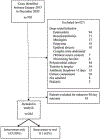Uncomplicated Streptococcal Bacteremia: The Era of Oral Antibiotic Step-down Therapy?
- PMID: 36690120
- PMCID: PMC10023366
- DOI: 10.1016/j.ijantimicag.2023.106736
Uncomplicated Streptococcal Bacteremia: The Era of Oral Antibiotic Step-down Therapy?
Abstract
Background: The purpose of this study was to compare the clinical outcomes of adults with uncomplicated streptococcal bacteremia who received either oral (PO) step-down or continued intravenous (IV) therapy.
Methods: This was a retrospective, single-center, cohort study, including adults admitted with Streptococcal bloodstream infection between January 1, 2013, and December 31, 2020. Only patients with uncomplicated Streptococcal bloodstream infections were included. Patients who transitioned to PO therapy within 5 days from bacteremia onset were compared to patients receiving continued IV therapy. The primary outcome was clinical failure, defined by either 90-day hospital readmission or mortality. Secondary outcomes included hospital length of stay (LOS) and antibiotic-related adverse events (AAEs).
Results: Of the 264 patients included, 42% were transitioned to PO therapy. Group B Streptococcus (22.7%) was the most common isolate. The most common sources of infection were skin and soft tissue (35%) and pulmonary (25%). Intensive care unit (ICU) stay was more common in the continued IV therapy group (22.2%) than in the PO step-down group (5.4%). The frequency of clinical failure was similar in the IV and PO groups (24.2% vs. 18.0%, P=0.23). The IV group had longer hospital LOS (median, [interquartile range (IQR)]) compared with the PO group (7 [5-13.5] vs. 4 [3-5] days, P<0.001). The incidence of AAEs was similar in the IV and PO groups (1.3% vs. 1.8%, P=0.74).
Conclusion: Oral antibiotic step-down therapy may be appropriate for the treatment of uncomplicated Streptococcal bacteremia, with consideration of factors such as patient comorbidities, type of infection, source control and clinical progress.
Keywords: Gram-positive cocci; Streptococcal infection; antimicrobial stewardship; bloodstream infection; oral step-down.
Copyright © 2023 Elsevier Ltd and International Society of Antimicrobial Chemotherapy. All rights reserved.
Similar articles
-
A Multicenter Retrospective Study Evaluating Intravenous to Oral Antibiotic Stepdown for Uncomplicated Streptococcal Bacteremia.Open Forum Infect Dis. 2024 Jun 28;11(7):ofae361. doi: 10.1093/ofid/ofae361. eCollection 2024 Jul. Open Forum Infect Dis. 2024. PMID: 38975249 Free PMC article.
-
A Retrospective Analysis of Intravenous vs Oral Antibiotic Step-Down Therapy for the Treatment of Uncomplicated Streptococcal Bloodstream Infections.J Clin Pharmacol. 2022 Nov;62(11):1372-1378. doi: 10.1002/jcph.2097. Epub 2022 Jun 21. J Clin Pharmacol. 2022. PMID: 35661173
-
Evaluation of step-down oral antibiotic therapy for uncomplicated streptococcal bloodstream infections on clinical outcomes.Ther Adv Infect Dis. 2022 Jan 30;9:20499361211073248. doi: 10.1177/20499361211073248. eCollection 2022 Jan-Dec. Ther Adv Infect Dis. 2022. PMID: 35127081 Free PMC article.
-
The Changing Landscape of Uncomplicated Gram-Negative Bacteremia: A Narrative Review to Guide Inpatient Management.J Hosp Med. 2020 Dec;15(12):746-753. doi: 10.12788/jhm.3414. J Hosp Med. 2020. PMID: 32853137 Review.
-
Continued Intravenous Versus First Week Transition to Oral Antibiotic Therapy in Bloodstream Infections: A Systematic Review and Meta-Analysis.Cureus. 2024 Jul 24;16(7):e65298. doi: 10.7759/cureus.65298. eCollection 2024 Jul. Cureus. 2024. PMID: 39184617 Free PMC article. Review.
Cited by
-
A Multicenter Retrospective Study Evaluating Intravenous to Oral Antibiotic Stepdown for Uncomplicated Streptococcal Bacteremia.Open Forum Infect Dis. 2024 Jun 28;11(7):ofae361. doi: 10.1093/ofid/ofae361. eCollection 2024 Jul. Open Forum Infect Dis. 2024. PMID: 38975249 Free PMC article.
-
Short Versus Long Antibiotic Duration in Streptococcus pneumoniae Bacteremia.Open Forum Infect Dis. 2024 Aug 30;11(9):ofae478. doi: 10.1093/ofid/ofae478. eCollection 2024 Sep. Open Forum Infect Dis. 2024. PMID: 39257675 Free PMC article. Clinical Trial.
-
Antibiotic duration and route for treatment of adults with uncomplicated streptococcal bloodstream infections: a retrospective study in a large healthcare system.Antimicrob Agents Chemother. 2024 Aug 7;68(8):e0022024. doi: 10.1128/aac.00220-24. Epub 2024 Jul 8. Antimicrob Agents Chemother. 2024. PMID: 38975753 Free PMC article.
-
Intravenous versus Partial Oral Antibiotic Therapy in the Treatment of Uncomplicated Bloodstream Infection Due to Streptococcus Species.Microorganisms. 2023 Sep 14;11(9):2313. doi: 10.3390/microorganisms11092313. Microorganisms. 2023. PMID: 37764157 Free PMC article.
-
Oral Antibiotics for Bacteremia and Infective Endocarditis: Current Evidence and Future Perspectives.Microorganisms. 2023 Dec 18;11(12):3004. doi: 10.3390/microorganisms11123004. Microorganisms. 2023. PMID: 38138148 Free PMC article. Review.
References
MeSH terms
Substances
Grants and funding
LinkOut - more resources
Full Text Sources
Medical


